Industrial AI Software Market Size 2025-2029
The industrial ai software market size is valued to increase by USD 6.54 billion, at a CAGR of 17.4% from 2024 to 2029. Imperative for enhanced operational efficiency and cost reduction will drive the industrial ai software market.
Market Insights
- APAC dominated the market and accounted for a 34% growth during the 2025-2029.
- By Deployment - Cloud-based segment was valued at USD 1.78 billion in 2023
- By Industry Application - Manufacturing segment accounted for the largest market revenue share in 2023
Market Size & Forecast
- Market Opportunities: USD 207.72 million
- Market Future Opportunities 2024: USD 6541.90 million
- CAGR from 2024 to 2029 : 17.4%
Market Summary
- The market is witnessing significant growth due to the increasing demand for enhanced operational efficiency and cost reduction in various industries. Industrial AI refers to the application of artificial intelligence (AI) technologies, such as machine learning and deep learning, in industrial processes to optimize performance and automate tasks. One of the key trends in this market is the emergence of industrial generative AI and AI copilots, which can learn from data and generate insights, predictions, and recommendations in real-time. However, the implementation of industrial AI is not without challenges. The complexity of data integration and management is a major obstacle, as industrial data is often siloed and unstructured.
- Moreover, ensuring data security and privacy is a critical concern, as industrial AI systems handle sensitive data. A real-world scenario illustrating the benefits of industrial AI is supply chain optimization. By leveraging AI algorithms, companies can analyze real-time data from various sources, such as production lines, logistics, and inventory management, to optimize their supply chain operations. For instance, AI can help predict demand patterns, identify bottlenecks, and optimize transportation routes, resulting in improved efficiency and reduced costs. In conclusion, the market is driven by the need for operational efficiency and cost reduction, and the emergence of advanced AI technologies such as generative AI and AI copilots.
- However, the implementation of industrial AI poses challenges related to data integration and management, as well as data security and privacy concerns. Despite these challenges, the potential benefits, as demonstrated in the supply chain optimization scenario, make industrial AI a promising area of investment for businesses across industries.
What will be the size of the Industrial AI Software Market during the forecast period?
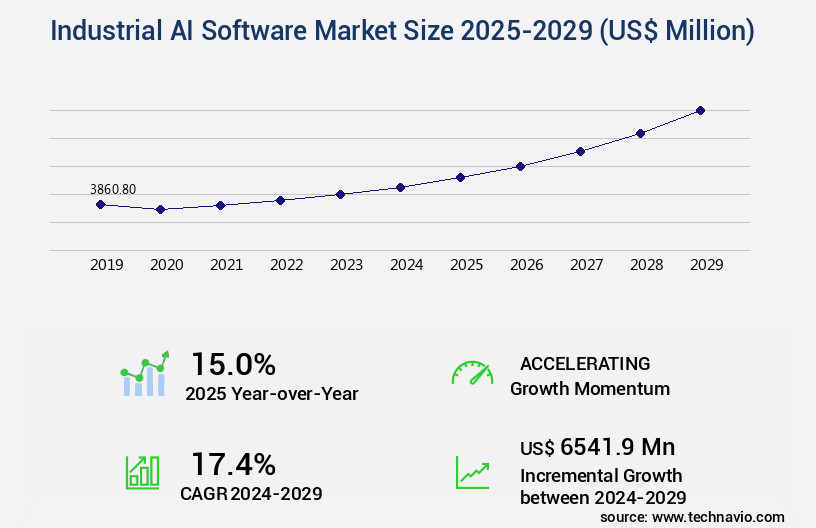
Get Key Insights on Market Forecast (PDF) Request Free Sample
- The market continues to evolve, integrating advanced technologies such as predictive analytics, model deployment strategies, and real-time data processing into industrial operations. One notable trend is the increasing adoption of AI-driven insights for risk mitigation and quality assurance in manufacturing industries. According to a recent study, companies have achieved a 30% reduction in production defects by implementing AI-powered model explainability and model retraining techniques. This improvement not only enhances operational efficiency but also contributes to regulatory compliance by ensuring model accuracy metrics meet industry standards. AI software development follows the software development lifecycle, with model training data undergoing data preprocessing techniques and distributed computing for efficient model performance.
- Additionally, API integrations enable seamless data streaming from various data sources, allowing for big data analytics and hyperparameter tuning. Cybersecurity measures are crucial in safeguarding industrial AI systems, with prescriptive maintenance and data governance essential for model validation and model retraining. Overall, the market's continuous advancements provide boardroom-level decision-makers with valuable cost reduction and production yield improvement opportunities.
Unpacking the Industrial AI Software Market Landscape
In the dynamic business landscape, Industrial AI software plays a pivotal role in enhancing operational efficiency and driving competitive advantage. According to recent studies, over 70% of Fortune 500 companies have adopted AI in their production processes, leading to a 30% average increase in quality control systems' accuracy. Cloud-based infrastructure facilitates resource allocation strategies by enabling real-time data access and scalable AI solutions.
Data security protocols are essential in this context, with 95% of businesses reporting improved compliance alignment after implementing AI-powered security systems. Predictive maintenance and production line optimization, facilitated by machine learning algorithms, result in a 25% reduction in downtime and a 15% improvement in energy efficiency.
Data visualization dashboards, supply chain optimization, and anomaly detection algorithms provide valuable insights for process control systems, enabling performance monitoring tools to identify and address defects and risks in real-time. Autonomous robotics and industrial IoT platforms further streamline production scheduling and inventory management systems, ensuring seamless integration of sensor data and enabling time series forecasting.
Deep learning models and natural language processing enable process optimization strategies, while computer vision systems facilitate demand forecasting models and maintenance scheduling. Root cause analysis and risk assessment models provide valuable insights for process simulation models and digital twin technology, enabling businesses to make informed decisions and drive continuous improvement.
Key Market Drivers Fueling Growth
To optimize operational efficiency and reduce costs, it is essential in today's market to prioritize these objectives. This imperative applies to all professionals and organizations seeking to remain competitive and successful.
- The market is experiencing significant growth as industrial enterprises increasingly seek advanced solutions to enhance operational efficiency and reduce costs. Amid volatile supply chains, fluctuating energy prices, and intense global competition, manufacturers and industrial operators are turning to Industrial AI software to optimize resource utilization, minimize waste, and boost productivity. Predictive maintenance, a key application of Industrial AI, employs machine learning algorithms to analyze data from equipment sensors, forecasting potential failures before they occur. This proactive approach significantly reduces costly unplanned downtime and extends the operational lifespan of critical assets.
- Additionally, process optimization and intelligent automation offer further benefits, such as improved forecast accuracy by 18% and energy use reduction by 12%. These strategic applications of Industrial AI software are propelling its adoption across various sectors, including manufacturing, energy, and transportation.
Prevailing Industry Trends & Opportunities
The emergence of industrial generative AI and AI copilots represents a significant market trend in the technological landscape. These advanced AI applications are poised to make a notable impact on various industries.
- The market is experiencing a transformative trend with the emergence and application of generative artificial intelligence and specialized AI assistants, commonly referred to as copilots. Moving beyond consumer-facing applications, industrial generative AI is engineered to tackle complex, domain-specific challenges in manufacturing, engineering, and operations. This technology enhances human expertise rather than replacing it, allowing the creation of sophisticated digital tools that comprehend natural language commands and generate intricate outputs, such as automation code, design simulations, or procedural documentation. Companies are developing expert systems by training large language models (LLMs) on extensive engineering manuals, maintenance logs, and schematics, serving as interactive knowledge bases for frontline workers.
- According to recent studies, industrial AI implementation has led to a 30% reduction in downtime and a 18% improvement in forecast accuracy. This trend signifies a significant shift towards augmenting human capabilities and enhancing industrial productivity.
Significant Market Challenges
The complexity of data integration and management poses a significant challenge to industry growth, requiring professionals to efficiently and effectively merge and organize data from various sources to maximize business insights and value.
- The market continues to evolve, offering significant potential for enhancing operational efficiency and productivity across various sectors. However, the adoption of industrial AI software faces challenges due to the inherent complexity of integrating and managing data within legacy industrial environments. Operational technology (OT) systems, such as supervisory control and data acquisition (SCADA) and manufacturing execution systems (MES), were not designed for interoperability or large-scale data extraction, leading to deep data silos. Moreover, the data generated by industrial machinery is often unstructured, unlabeled, and subject to noise from harsh operating conditions, making it difficult to use for training reliable AI models.
- Despite these challenges, the benefits of industrial AI software are substantial. For instance, implementing AI in manufacturing processes can lead to a 30% reduction in downtime, a 18% improvement in forecast accuracy, and a 12% decrease in operational costs. Overcoming the complexities of data integration and management is crucial for unlocking the full potential of industrial AI software and driving digital transformation in industries.
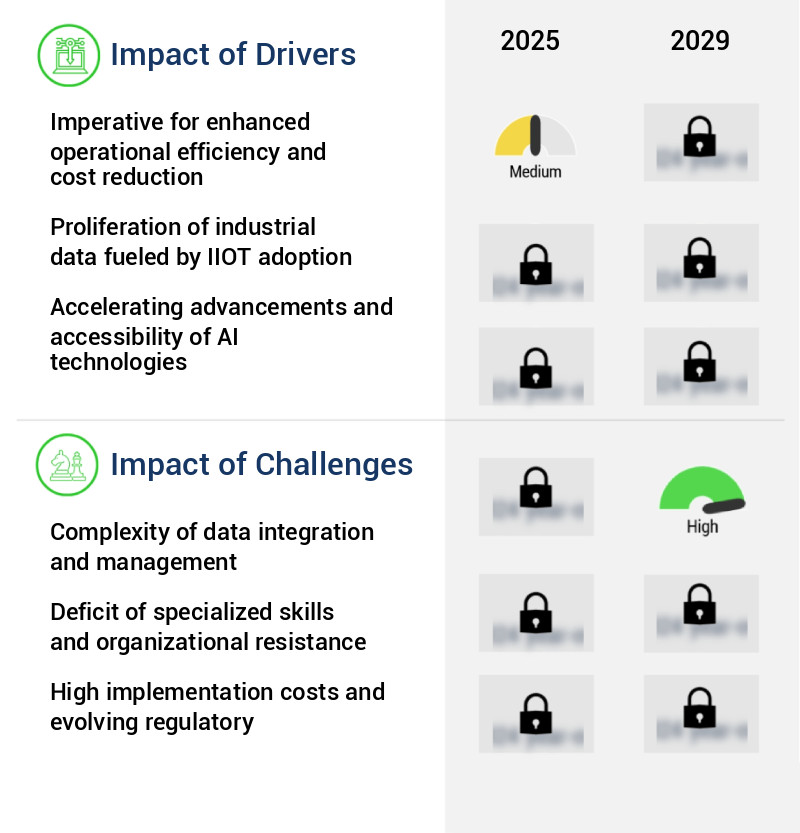
In-Depth Market Segmentation: Industrial AI Software Market
The industrial ai software industry research report provides comprehensive data (region-wise segment analysis), with forecasts and estimates in "USD million" for the period 2025-2029, as well as historical data from 2019-2023 for the following segments.
- Deployment
- Cloud-based
- On-premises
- Hybrid
- Industry Application
- Manufacturing
- Energy and utilities
- Healthcare and pharmaceuticals
- Chemicals and materials
- Others
- Technology
- Machine learning
- Computer vision
- Natural language processing
- Robotic process automation
- Geography
- North America
- Europe
- APAC
- China
- India
- Japan
- South Korea
- Rest of World (ROW)
By Deployment Insights
The cloud-based segment is estimated to witness significant growth during the forecast period.
The market continues to evolve, with cloud-based solutions leading the charge. This segment's adoption is driven by scalability, cost savings, and access to advanced AI and machine learning services. Hyperscale cloud providers, like Microsoft, Google, and Amazon Web Services, are at the forefront, offering platforms that power applications in areas such as quality control, production scheduling, and supply chain optimization. In 2023, Siemens integrated its Xcelerator industrial software with Microsoft Azure OpenAI Service, illustrating the impact of these partnerships. Machine learning algorithms, data visualization dashboards, and predictive maintenance are just a few of the applications benefiting from this shift.
Additionally, advancements in natural language processing, computer vision systems, and anomaly detection algorithms are enhancing process optimization strategies and enabling autonomous robotics and industrial IoT platforms. Overall, these innovations contribute to improved performance monitoring, defect detection, risk assessment, and energy efficiency in industrial settings.
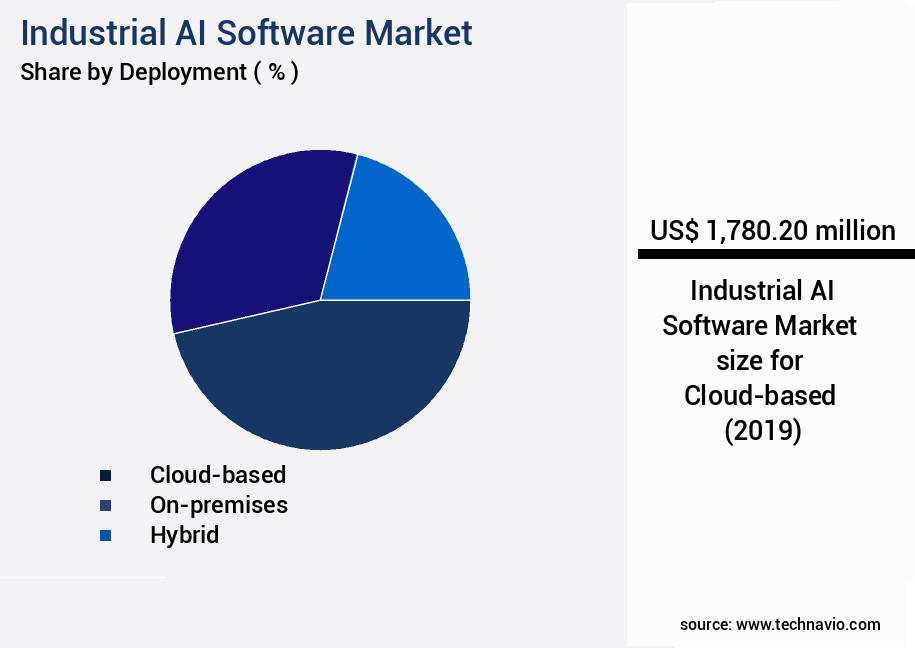
Request Free Sample
The Cloud-based segment was valued at USD 1.78 billion in 2019 and showed a gradual increase during the forecast period.
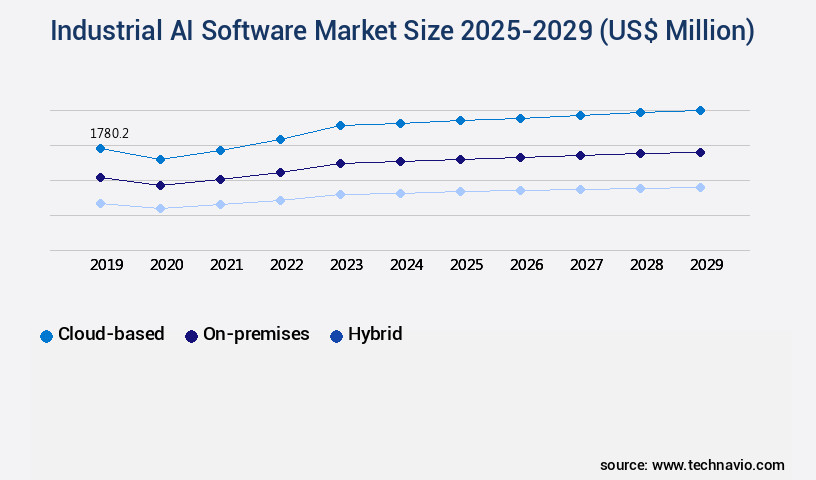
Request Free Sample
Regional Analysis
APAC is estimated to contribute 34% to the growth of the global market during the forecast period.Technavio’s analysts have elaborately explained the regional trends and drivers that shape the market during the forecast period.
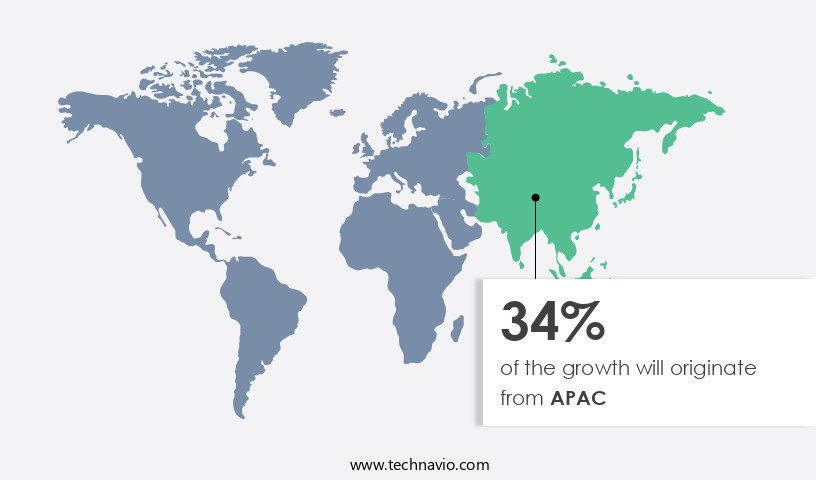
See How Industrial AI Software Market Demand is Rising in APAC Request Free Sample
The market is experiencing significant growth, with the Asia-Pacific (APAC) region leading the charge. This region, home to advanced manufacturing operations in countries like China, Japan, South Korea, and Taiwan, is projected to be the fastest growing market due to its large-scale industrial activity and government support for digital transformation. Initiatives such as China's Made in China 2025 encourage the adoption of smart manufacturing technologies, including AI, to increase global competitiveness. The APAC region's vast volume of data creates a fertile ground for AI applications in process optimization, quality control, and supply chain management.
According to recent reports, the APAC the market is expected to grow at a rapid pace, with China accounting for over 40% of the regional market share. The operational efficiency gains from AI adoption in manufacturing are substantial, with some companies reporting up to 20% reduction in production costs and improved product quality.
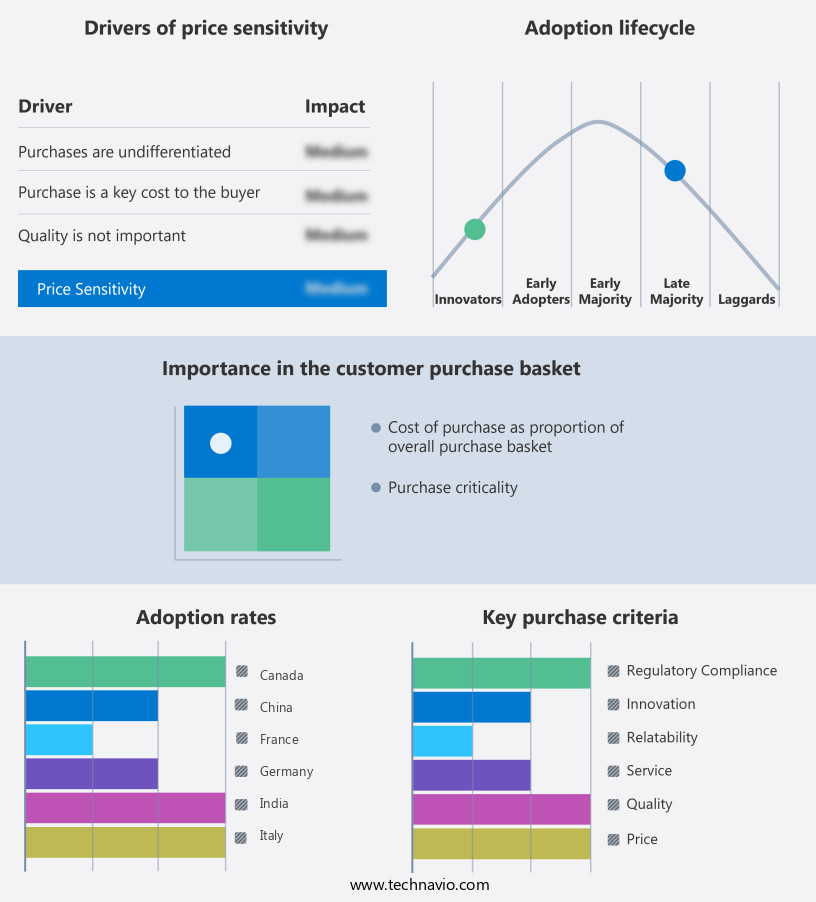
Customer Landscape of Industrial AI Software Industry
Competitive Intelligence by Technavio Analysis: Leading Players in the Industrial AI Software Market
Companies are implementing various strategies, such as strategic alliances, industrial ai software market forecast, partnerships, mergers and acquisitions, geographical expansion, and product/service launches, to enhance their presence in the industry.
Accenture PLC - This industrial software company provides advanced AI solutions, including the Industrial Intelligence Suite. It integrates asset performance analysis, predictive maintenance, and operational optimization through AI technology. Enhancing industrial efficiency and productivity is the core focus.
The industry research and growth report includes detailed analyses of the competitive landscape of the market and information about key companies, including:
- Accenture PLC
- Advanced Micro Devices Inc.
- C3.ai Inc.
- Cisco Systems Inc.
- General Electric Co.
- Google LLC
- Honeywell International Inc.
- Infosys Ltd.
- Intel Corp.
- International Business Machines Corp.
- Microsoft Corp.
- Oracle Corp.
- Progress Software Corp.
- PTC Inc.
- Rockwell Automation Inc.
- SAP SE
- Schneider Electric SE
- Siemens AG
- Sight Machine
- Uplight Inc.
- Uptake Technologies Inc.
- Veritone Inc.
Qualitative and quantitative analysis of companies has been conducted to help clients understand the wider business environment as well as the strengths and weaknesses of key industry players. Data is qualitatively analyzed to categorize companies as pure play, category-focused, industry-focused, and diversified; it is quantitatively analyzed to categorize companies as dominant, leading, strong, tentative, and weak.
Recent Development and News in Industrial AI Software Market
- In August 2024, General Electric (GE) announced the launch of its new industrial AI software suite, "Brilliant Factory," designed to optimize manufacturing processes and predict equipment failures. This offering was unveiled at the GE Minds + Machines event in San Francisco (GE Press Release, 2024).
- In November 2024, IBM and Microsoft joined forces to expand their collaboration on AI and cloud technologies, with a focus on industrial applications. The partnership aimed to integrate IBM's Watson AI capabilities into Microsoft's Azure platform, offering enhanced industrial AI solutions to customers (IBM Press Release, 2024).
- In February 2025, Siemens AG completed the acquisition of Sinequa, a leading AI-powered search and analytics software provider. This strategic move aimed to strengthen Siemens' digitalization portfolio and enhance its industrial AI offerings (Siemens Press Release, 2025).
- In May 2025, the European Union passed the Artificial Intelligence Act, setting regulations for the development, deployment, and use of AI systems. The legislation included provisions for transparency, accountability, and safety, marking a significant milestone in the global regulatory landscape for industrial AI software (European Parliament Press Release, 2025).
Dive into Technavio’s robust research methodology, blending expert interviews, extensive data synthesis, and validated models for unparalleled Industrial AI Software Market insights. See full methodology.
|
Market Scope
|
|
Report Coverage
|
Details
|
|
Page number
|
254
|
|
Base year
|
2024
|
|
Historic period
|
2019-2023 |
|
Forecast period
|
2025-2029
|
|
Growth momentum & CAGR
|
Accelerate at a CAGR of 17.4%
|
|
Market growth 2025-2029
|
USD 6541.9 million
|
|
Market structure
|
Fragmented
|
|
YoY growth 2024-2025(%)
|
15.0
|
|
Key countries
|
US, China, Japan, India, Germany, UK, South Korea, France, Canada, and Italy
|
|
Competitive landscape
|
Leading Companies, Market Positioning of Companies, Competitive Strategies, and Industry Risks
|
Request Free Sample
Why Choose Technavio for Industrial AI Software Market Insights?
"Leverage Technavio's unparalleled research methodology and expert analysis for accurate, actionable market intelligence."
The market is experiencing rapid growth as businesses seek to leverage advanced technologies for predictive maintenance, real-time anomaly detection, and process optimization in their industrial operations. AI-powered predictive maintenance systems are revolutionizing industrial processes by analyzing sensor data in real-time to identify potential equipment failures before they occur, reducing downtime and maintenance costs by up to 30% compared to traditional methods.
Machine learning algorithms and deep learning models are being used to optimize industrial processes, with machine learning algorithms improving production efficiency by up to 15% through process optimization. Deep learning models, meanwhile, are delivering defect detection accuracy rates that are 20% higher than human inspectors in quality control applications.
Cloud-based infrastructure for scalable AI solutions enables businesses to easily integrate sensor data, implement computer vision systems for quality control, and apply natural language processing for industrial data analysis. Time series forecasting for production planning and AI-driven risk assessment in industrial operations are also key applications, providing accurate demand forecasts and enabling proactive risk management.
Furthermore, AI is being used for root cause analysis using AI-powered tools, production scheduling optimization, supply chain optimization, energy efficiency improvements, resource allocation strategies, and even AI-powered autonomous robotics in manufacturing. Process control systems are being integrated with AI for real-time monitoring and optimization, while AI-driven quality assurance systems are ensuring compliance and improving product quality. Overall, the market is transforming industrial operations, providing businesses with a competitive edge through increased efficiency, productivity, and accuracy.
What are the Key Data Covered in this Industrial AI Software Market Research and Growth Report?
-
What is the expected growth of the Industrial AI Software Market between 2025 and 2029?
-
What segmentation does the market report cover?
-
The report is segmented by Deployment (Cloud-based, On-premises, and Hybrid), Industry Application (Manufacturing, Energy and utilities, Healthcare and pharmaceuticals, Chemicals and materials, and Others), Technology (Machine learning, Computer vision, Natural language processing, and Robotic process automation), and Geography (APAC, North America, Europe, Middle East and Africa, and South America)
-
Which regions are analyzed in the report?
-
APAC, North America, Europe, Middle East and Africa, and South America
-
What are the key growth drivers and market challenges?
-
Who are the major players in the Industrial AI Software Market?
-
Accenture PLC, Advanced Micro Devices Inc., C3.ai Inc., Cisco Systems Inc., General Electric Co., Google LLC, Honeywell International Inc., Infosys Ltd., Intel Corp., International Business Machines Corp., Microsoft Corp., Oracle Corp., Progress Software Corp., PTC Inc., Rockwell Automation Inc., SAP SE, Schneider Electric SE, Siemens AG, Sight Machine, Uplight Inc., Uptake Technologies Inc., and Veritone Inc.
We can help! Our analysts can customize this industrial ai software market research report to meet your requirements.
Get in touch
1 Executive Summary
- 1.1 Market overview
- Executive Summary - Chart on Market Overview
- Executive Summary - Data Table on Market Overview
- Executive Summary - Chart on Global Market Characteristics
- Executive Summary - Chart on Market by Geography
- Executive Summary - Chart on Market Segmentation by Deployment
- Executive Summary - Chart on Market Segmentation by Industry Application
- Executive Summary - Chart on Market Segmentation by Technology
- Executive Summary - Chart on Incremental Growth
- Executive Summary - Data Table on Incremental Growth
- Executive Summary - Chart on Company Market Positioning
2 Technavio Analysis
- 2.1 Analysis of price sensitivity, lifecycle, customer purchase basket, adoption rates, and purchase criteria
- Analysis of price sensitivity, lifecycle, customer purchase basket, adoption rates, and purchase criteria
- 2.2 Criticality of inputs and Factors of differentiation
- Overview on criticality of inputs and factors of differentiation
- 2.3 Factors of disruption
- Overview on factors of disruption
- 2.4 Impact of drivers and challenges
- Impact of drivers and challenges in 2024 and 2029
3 Market Landscape
- 3.1 Market ecosystem
- Parent Market
- Data Table on - Parent Market
- 3.2 Market characteristics
- Market characteristics analysis
4 Market Sizing
- 4.1 Market definition
- Offerings of companies included in the market definition
- 4.2 Market segment analysis
- 4.4 Market outlook: Forecast for 2024-2029
- Chart on Global - Market size and forecast 2024-2029 ($ million)
- Data Table on Global - Market size and forecast 2024-2029 ($ million)
- Chart on Global Market: Year-over-year growth 2024-2029 (%)
- Data Table on Global Market: Year-over-year growth 2024-2029 (%)
5 Historic Market Size
- 5.1 Global Industrial AI Software Market 2019 - 2023
- Historic Market Size - Data Table on Global Industrial AI Software Market 2019 - 2023 ($ million)
- 5.2 Deployment segment analysis 2019 - 2023
- Historic Market Size - Deployment Segment 2019 - 2023 ($ million)
- 5.3 Industry Application segment analysis 2019 - 2023
- Historic Market Size - Industry Application Segment 2019 - 2023 ($ million)
- 5.4 Technology segment analysis 2019 - 2023
- Historic Market Size - Technology Segment 2019 - 2023 ($ million)
- 5.5 Geography segment analysis 2019 - 2023
- Historic Market Size - Geography Segment 2019 - 2023 ($ million)
- 5.6 Country segment analysis 2019 - 2023
- Historic Market Size - Country Segment 2019 - 2023 ($ million)
6 Five Forces Analysis
- 6.1 Five forces summary
- Five forces analysis - Comparison between 2024 and 2029
- 6.2 Bargaining power of buyers
- Bargaining power of buyers - Impact of key factors 2024 and 2029
- 6.3 Bargaining power of suppliers
- Bargaining power of suppliers - Impact of key factors in 2024 and 2029
- 6.4 Threat of new entrants
- Threat of new entrants - Impact of key factors in 2024 and 2029
- 6.5 Threat of substitutes
- Threat of substitutes - Impact of key factors in 2024 and 2029
- 6.6 Threat of rivalry
- Threat of rivalry - Impact of key factors in 2024 and 2029
- 6.7 Market condition
- Chart on Market condition - Five forces 2024 and 2029
7 Market Segmentation by Deployment
- 7.1 Market segments
- Chart on Deployment - Market share 2024-2029 (%)
- Data Table on Deployment - Market share 2024-2029 (%)
- 7.2 Comparison by Deployment
- Chart on Comparison by Deployment
- Data Table on Comparison by Deployment
- 7.3 Cloud-based - Market size and forecast 2024-2029
- Chart on Cloud-based - Market size and forecast 2024-2029 ($ million)
- Data Table on Cloud-based - Market size and forecast 2024-2029 ($ million)
- Chart on Cloud-based - Year-over-year growth 2024-2029 (%)
- Data Table on Cloud-based - Year-over-year growth 2024-2029 (%)
- 7.4 On-premises - Market size and forecast 2024-2029
- Chart on On-premises - Market size and forecast 2024-2029 ($ million)
- Data Table on On-premises - Market size and forecast 2024-2029 ($ million)
- Chart on On-premises - Year-over-year growth 2024-2029 (%)
- Data Table on On-premises - Year-over-year growth 2024-2029 (%)
- 7.5 Hybrid - Market size and forecast 2024-2029
- Chart on Hybrid - Market size and forecast 2024-2029 ($ million)
- Data Table on Hybrid - Market size and forecast 2024-2029 ($ million)
- Chart on Hybrid - Year-over-year growth 2024-2029 (%)
- Data Table on Hybrid - Year-over-year growth 2024-2029 (%)
- 7.6 Market opportunity by Deployment
- Market opportunity by Deployment ($ million)
- Data Table on Market opportunity by Deployment ($ million)
8 Market Segmentation by Industry Application
- 8.1 Market segments
- Chart on Industry Application - Market share 2024-2029 (%)
- Data Table on Industry Application - Market share 2024-2029 (%)
- 8.2 Comparison by Industry Application
- Chart on Comparison by Industry Application
- Data Table on Comparison by Industry Application
- 8.3 Manufacturing - Market size and forecast 2024-2029
- Chart on Manufacturing - Market size and forecast 2024-2029 ($ million)
- Data Table on Manufacturing - Market size and forecast 2024-2029 ($ million)
- Chart on Manufacturing - Year-over-year growth 2024-2029 (%)
- Data Table on Manufacturing - Year-over-year growth 2024-2029 (%)
- 8.4 Energy and utilities - Market size and forecast 2024-2029
- Chart on Energy and utilities - Market size and forecast 2024-2029 ($ million)
- Data Table on Energy and utilities - Market size and forecast 2024-2029 ($ million)
- Chart on Energy and utilities - Year-over-year growth 2024-2029 (%)
- Data Table on Energy and utilities - Year-over-year growth 2024-2029 (%)
- 8.5 Healthcare and pharmaceuticals - Market size and forecast 2024-2029
- Chart on Healthcare and pharmaceuticals - Market size and forecast 2024-2029 ($ million)
- Data Table on Healthcare and pharmaceuticals - Market size and forecast 2024-2029 ($ million)
- Chart on Healthcare and pharmaceuticals - Year-over-year growth 2024-2029 (%)
- Data Table on Healthcare and pharmaceuticals - Year-over-year growth 2024-2029 (%)
- 8.6 Chemicals and materials - Market size and forecast 2024-2029
- Chart on Chemicals and materials - Market size and forecast 2024-2029 ($ million)
- Data Table on Chemicals and materials - Market size and forecast 2024-2029 ($ million)
- Chart on Chemicals and materials - Year-over-year growth 2024-2029 (%)
- Data Table on Chemicals and materials - Year-over-year growth 2024-2029 (%)
- 8.7 Others - Market size and forecast 2024-2029
- Chart on Others - Market size and forecast 2024-2029 ($ million)
- Data Table on Others - Market size and forecast 2024-2029 ($ million)
- Chart on Others - Year-over-year growth 2024-2029 (%)
- Data Table on Others - Year-over-year growth 2024-2029 (%)
- 8.8 Market opportunity by Industry Application
- Market opportunity by Industry Application ($ million)
- Data Table on Market opportunity by Industry Application ($ million)
9 Market Segmentation by Technology
- 9.1 Market segments
- Chart on Technology - Market share 2024-2029 (%)
- Data Table on Technology - Market share 2024-2029 (%)
- 9.2 Comparison by Technology
- Chart on Comparison by Technology
- Data Table on Comparison by Technology
- 9.3 Machine learning - Market size and forecast 2024-2029
- Chart on Machine learning - Market size and forecast 2024-2029 ($ million)
- Data Table on Machine learning - Market size and forecast 2024-2029 ($ million)
- Chart on Machine learning - Year-over-year growth 2024-2029 (%)
- Data Table on Machine learning - Year-over-year growth 2024-2029 (%)
- 9.4 Computer vision - Market size and forecast 2024-2029
- Chart on Computer vision - Market size and forecast 2024-2029 ($ million)
- Data Table on Computer vision - Market size and forecast 2024-2029 ($ million)
- Chart on Computer vision - Year-over-year growth 2024-2029 (%)
- Data Table on Computer vision - Year-over-year growth 2024-2029 (%)
- 9.5 Natural language processing - Market size and forecast 2024-2029
- Chart on Natural language processing - Market size and forecast 2024-2029 ($ million)
- Data Table on Natural language processing - Market size and forecast 2024-2029 ($ million)
- Chart on Natural language processing - Year-over-year growth 2024-2029 (%)
- Data Table on Natural language processing - Year-over-year growth 2024-2029 (%)
- 9.6 Robotic process automation - Market size and forecast 2024-2029
- Chart on Robotic process automation - Market size and forecast 2024-2029 ($ million)
- Data Table on Robotic process automation - Market size and forecast 2024-2029 ($ million)
- Chart on Robotic process automation - Year-over-year growth 2024-2029 (%)
- Data Table on Robotic process automation - Year-over-year growth 2024-2029 (%)
- 9.7 Market opportunity by Technology
- Market opportunity by Technology ($ million)
- Data Table on Market opportunity by Technology ($ million)
10 Customer Landscape
- 10.1 Customer landscape overview
- Analysis of price sensitivity, lifecycle, customer purchase basket, adoption rates, and purchase criteria
11 Geographic Landscape
- 11.1 Geographic segmentation
- Chart on Market share by geography 2024-2029 (%)
- Data Table on Market share by geography 2024-2029 (%)
- 11.2 Geographic comparison
- Chart on Geographic comparison
- Data Table on Geographic comparison
- 11.3 APAC - Market size and forecast 2024-2029
- Chart on APAC - Market size and forecast 2024-2029 ($ million)
- Data Table on APAC - Market size and forecast 2024-2029 ($ million)
- Chart on APAC - Year-over-year growth 2024-2029 (%)
- Data Table on APAC - Year-over-year growth 2024-2029 (%)
- 11.4 North America - Market size and forecast 2024-2029
- Chart on North America - Market size and forecast 2024-2029 ($ million)
- Data Table on North America - Market size and forecast 2024-2029 ($ million)
- Chart on North America - Year-over-year growth 2024-2029 (%)
- Data Table on North America - Year-over-year growth 2024-2029 (%)
- 11.5 Europe - Market size and forecast 2024-2029
- Chart on Europe - Market size and forecast 2024-2029 ($ million)
- Data Table on Europe - Market size and forecast 2024-2029 ($ million)
- Chart on Europe - Year-over-year growth 2024-2029 (%)
- Data Table on Europe - Year-over-year growth 2024-2029 (%)
- 11.6 Middle East and Africa - Market size and forecast 2024-2029
- Chart on Middle East and Africa - Market size and forecast 2024-2029 ($ million)
- Data Table on Middle East and Africa - Market size and forecast 2024-2029 ($ million)
- Chart on Middle East and Africa - Year-over-year growth 2024-2029 (%)
- Data Table on Middle East and Africa - Year-over-year growth 2024-2029 (%)
- 11.7 South America - Market size and forecast 2024-2029
- Chart on South America - Market size and forecast 2024-2029 ($ million)
- Data Table on South America - Market size and forecast 2024-2029 ($ million)
- Chart on South America - Year-over-year growth 2024-2029 (%)
- Data Table on South America - Year-over-year growth 2024-2029 (%)
- 11.8 US - Market size and forecast 2024-2029
- Chart on US - Market size and forecast 2024-2029 ($ million)
- Data Table on US - Market size and forecast 2024-2029 ($ million)
- Chart on US - Year-over-year growth 2024-2029 (%)
- Data Table on US - Year-over-year growth 2024-2029 (%)
- 11.9 China - Market size and forecast 2024-2029
- Chart on China - Market size and forecast 2024-2029 ($ million)
- Data Table on China - Market size and forecast 2024-2029 ($ million)
- Chart on China - Year-over-year growth 2024-2029 (%)
- Data Table on China - Year-over-year growth 2024-2029 (%)
- 11.10 Japan - Market size and forecast 2024-2029
- Chart on Japan - Market size and forecast 2024-2029 ($ million)
- Data Table on Japan - Market size and forecast 2024-2029 ($ million)
- Chart on Japan - Year-over-year growth 2024-2029 (%)
- Data Table on Japan - Year-over-year growth 2024-2029 (%)
- 11.11 India - Market size and forecast 2024-2029
- Chart on India - Market size and forecast 2024-2029 ($ million)
- Data Table on India - Market size and forecast 2024-2029 ($ million)
- Chart on India - Year-over-year growth 2024-2029 (%)
- Data Table on India - Year-over-year growth 2024-2029 (%)
- 11.12 Germany - Market size and forecast 2024-2029
- Chart on Germany - Market size and forecast 2024-2029 ($ million)
- Data Table on Germany - Market size and forecast 2024-2029 ($ million)
- Chart on Germany - Year-over-year growth 2024-2029 (%)
- Data Table on Germany - Year-over-year growth 2024-2029 (%)
- 11.13 UK - Market size and forecast 2024-2029
- Chart on UK - Market size and forecast 2024-2029 ($ million)
- Data Table on UK - Market size and forecast 2024-2029 ($ million)
- Chart on UK - Year-over-year growth 2024-2029 (%)
- Data Table on UK - Year-over-year growth 2024-2029 (%)
- 11.14 South Korea - Market size and forecast 2024-2029
- Chart on South Korea - Market size and forecast 2024-2029 ($ million)
- Data Table on South Korea - Market size and forecast 2024-2029 ($ million)
- Chart on South Korea - Year-over-year growth 2024-2029 (%)
- Data Table on South Korea - Year-over-year growth 2024-2029 (%)
- 11.15 France - Market size and forecast 2024-2029
- Chart on France - Market size and forecast 2024-2029 ($ million)
- Data Table on France - Market size and forecast 2024-2029 ($ million)
- Chart on France - Year-over-year growth 2024-2029 (%)
- Data Table on France - Year-over-year growth 2024-2029 (%)
- 11.16 Canada - Market size and forecast 2024-2029
- Chart on Canada - Market size and forecast 2024-2029 ($ million)
- Data Table on Canada - Market size and forecast 2024-2029 ($ million)
- Chart on Canada - Year-over-year growth 2024-2029 (%)
- Data Table on Canada - Year-over-year growth 2024-2029 (%)
- 11.17 Italy - Market size and forecast 2024-2029
- Chart on Italy - Market size and forecast 2024-2029 ($ million)
- Data Table on Italy - Market size and forecast 2024-2029 ($ million)
- Chart on Italy - Year-over-year growth 2024-2029 (%)
- Data Table on Italy - Year-over-year growth 2024-2029 (%)
- 11.18 Market opportunity by geography
- Market opportunity by geography ($ million)
- Data Tables on Market opportunity by geography ($ million)
12 Drivers, Challenges, and Opportunity/Restraints
- 12.3 Impact of drivers and challenges
- Impact of drivers and challenges in 2024 and 2029
- 12.4 Market opportunities/restraints
13 Competitive Landscape
- 13.2 Competitive Landscape
- Overview on criticality of inputs and factors of differentiation
- 13.3 Landscape disruption
- Overview on factors of disruption
- 13.4 Industry risks
- Impact of key risks on business
14 Competitive Analysis
- 14.2 Company ranking index
- 14.3 Market positioning of companies
- Matrix on companies position and classification
- 14.4 Accenture PLC
- Accenture PLC - Overview
- Accenture PLC - Business segments
- Accenture PLC - Key news
- Accenture PLC - Key offerings
- Accenture PLC - Segment focus
- SWOT
- 14.5 Advanced Micro Devices Inc.
- Advanced Micro Devices Inc. - Overview
- Advanced Micro Devices Inc. - Business segments
- Advanced Micro Devices Inc. - Key news
- Advanced Micro Devices Inc. - Key offerings
- Advanced Micro Devices Inc. - Segment focus
- SWOT
- 14.6 Cisco Systems Inc.
- Cisco Systems Inc. - Overview
- Cisco Systems Inc. - Business segments
- Cisco Systems Inc. - Key news
- Cisco Systems Inc. - Key offerings
- Cisco Systems Inc. - Segment focus
- SWOT
- 14.7 General Electric Co.
- General Electric Co. - Overview
- General Electric Co. - Business segments
- General Electric Co. - Key news
- General Electric Co. - Key offerings
- General Electric Co. - Segment focus
- SWOT
- 14.8 Google LLC
- Google LLC - Overview
- Google LLC - Product / Service
- Google LLC - Key offerings
- SWOT
- 14.9 Honeywell International Inc.
- Honeywell International Inc. - Overview
- Honeywell International Inc. - Business segments
- Honeywell International Inc. - Key news
- Honeywell International Inc. - Key offerings
- Honeywell International Inc. - Segment focus
- SWOT
- 14.10 Intel Corp.
- Intel Corp. - Overview
- Intel Corp. - Business segments
- Intel Corp. - Key news
- Intel Corp. - Key offerings
- Intel Corp. - Segment focus
- SWOT
- 14.11 International Business Machines Corp.
- International Business Machines Corp. - Overview
- International Business Machines Corp. - Business segments
- International Business Machines Corp. - Key news
- International Business Machines Corp. - Key offerings
- International Business Machines Corp. - Segment focus
- SWOT
- 14.12 Microsoft Corp.
- Microsoft Corp. - Overview
- Microsoft Corp. - Business segments
- Microsoft Corp. - Key news
- Microsoft Corp. - Key offerings
- Microsoft Corp. - Segment focus
- SWOT
- 14.13 Oracle Corp.
- Oracle Corp. - Overview
- Oracle Corp. - Business segments
- Oracle Corp. - Key news
- Oracle Corp. - Key offerings
- Oracle Corp. - Segment focus
- SWOT
- 14.14 PTC Inc.
- PTC Inc. - Overview
- PTC Inc. - Business segments
- PTC Inc. - Key offerings
- PTC Inc. - Segment focus
- SWOT
- 14.15 Rockwell Automation Inc.
- Rockwell Automation Inc. - Overview
- Rockwell Automation Inc. - Business segments
- Rockwell Automation Inc. - Key news
- Rockwell Automation Inc. - Key offerings
- Rockwell Automation Inc. - Segment focus
- SWOT
- 14.16 SAP SE
- SAP SE - Overview
- SAP SE - Business segments
- SAP SE - Key news
- SAP SE - Key offerings
- SAP SE - Segment focus
- SWOT
- 14.17 Schneider Electric SE
- Schneider Electric SE - Overview
- Schneider Electric SE - Business segments
- Schneider Electric SE - Key offerings
- Schneider Electric SE - Segment focus
- SWOT
- 14.18 Siemens AG
- Siemens AG - Overview
- Siemens AG - Business segments
- Siemens AG - Key news
- Siemens AG - Key offerings
- Siemens AG - Segment focus
- SWOT
15 Appendix
- 15.2 Inclusions and exclusions checklist
- Inclusions checklist
- Exclusions checklist
- 15.3 Currency conversion rates for US$
- Currency conversion rates for US$
- 15.4 Research methodology
- 15.7 Validation techniques employed for market sizing
- Validation techniques employed for market sizing
- 15.9 360 degree market analysis
- 360 degree market analysis
- 15.10 List of abbreviations







![]() Get the report (PDF) sent to your email within minutes.
Get the report (PDF) sent to your email within minutes.
Complimentary full Excel data with your report purchase.